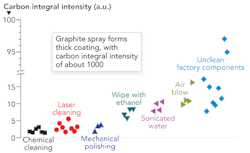Transitioning laser technology from university to industry
Early cooperation crucial
Lin Li
University research is usually curiosity-driven to discover and to create. Not all research outcomes are exploited by industry. Publication in peer-reviewed journals is a key measure of the research outputs from universities. A vast amount of knowledge and novel techniques developed in university research laboratories have not been deployed in industry, largely because of the differences between university research that is mainly at low Technology Readiness Levels (TRL) of 1–3 (demonstration of concept, the feasibility, and basic process characteristics) and industry, where a further five levels (TRL4–9) are needed, and considerable resources and commitments are required. Often industries are only interested in a technology take-up that has demonstrated to TRL6 (component manufacture in industrial environments, quality certifications, reliability and repeatability). University laboratories are not well suited for TRL4–6.
This article uses an example of a successful transition from university laboratory to industrial production in laser processing (laser cleaning for aero-engine production at Rolls-Royce developed at The University of Manchester) to demonstrate a route for technology transfer from basic science to wealth creation in industry.
The industrial demand
In almost all industrial sectors, surface cleaning is an often-required part of manufacturing processes as a preparation stage for joining, welding, bonding, coating, or for remanufacturing of dies and molds and rust/paint cleaning. In most cases, manual cleaning by detergent or shot blasting using high-speed solid particles or dry ice is used. In some specific cases, such as in aerospace component manufacture with electron beam welding or diffusion bonding, surfaces of components to be assembled are required to be free from any contamination. Often, concentrated hydrofluoric acid (HF) is used for surface cleaning. While it is an effective method to provide clean surfaces, it is highly corrosive and hazardous. Handling and disposal of HF are high-cost activities, and many industries are looking for alternative solutions. In addition, some residuals may be left on the surface of components if the acid bath is contaminated with various impurities.
Setting up the partnership
In 2004, Rolls-Royce came to the Laser Processing Research Laboratory of the University of Manchester Institute of Science and Technology (UMIST), proposing to fund a PhD studentship in laser processing, with a company employee as a part time PhD student. Following an initial investigation of company needs across various manufacturing processes, laser cleaning was identified to be a key technology that would benefit Rolls-Royce. To support the research, the UK Northwest Science Council provided further funding for a postdoctoral fellow and technical support staff to assist the project at the university. Therefore, a team of researchers was assembled...
The research
After four years of research investigating laser interactions with various types of contaminants, including machining coolants, grease, silicon, synthetic oil, and various aerospace alloys: Ti-6Al-4V, Ti-6Al-2Sn-4Zr-6Mo and IMI834, the basic characteristics of nanosecond-pulsed Nd:YAG laser, CO2 laser, and excimer laser interactions with these materials were understood through both experimental and theoretical studies [1–4]. Having selected a suitable laser system and an operating window to ensure contaminants were removed and the substrates were not damaged, a series of tests on the suitability of the laser-cleaned surfaces for electron beam welding were conducted using the Rolls-Royce E-beam welding facility in Derby, involving a Rolls-Royce engineer. The company's standard quality control procedures were applied, and the process was certified. This evaluation process involved the university team, which provided the test samples and actively interacted with the company staff.
Industrial deployment and benefits
Following the university research and industrial quality certification, Rolls-Royce decided to introduce laser cleaning for E-beam welding surface preparation, supported by The UMIST team. By May 2013, Rolls-Royce had successfully applied the laser cleaning technology in the production of 24 different aero-engine component types across most of the engine families. FIGURE 1 shows a laser cleaning system used at Rolls-Royce in Derby. The benefits of introducing laser cleaning include the reduction of scrap rates, a faster speed than manual cleaning, and avoidance of hazardous chemicals. The project demonstrates an example of successful university–industry collaboration for developing and implementing advanced sustainable manufacturing technologies for the UK industry.
Wider applications
Following the success of applying laser cleaning at Rolls-Royce, both Rolls-Royce and BAE Systems (a largest defense system manufacturer in Europe) have engaged with The University of Manchester Laser Processing Research Centre to develop the technology further for diffusion bonding applications and for the development of an in-process monitoring technique. Co-sponsored by the companies and the UK government funding agencies, the project is called SAMULET for Strategic Affordable Manufacturing in the UK with Leading Environmental Technology. An example of a laser-cleaned Ti alloy surface is shown in FIGURE 2. The assessment of laser cleaning against other cleaning methods was carried out. FIGURE 3 shows the surface cleanliness of various cleaning methods measured using glow discharge optical emission spectroscopy (GDOES).
This project resulted in the process of transitioning laser cleaning technology to BAE Systems for aircraft production. An in-process monitoring system for laser cleaning developed in the project is now being deployed at Rolls-Royce. In addition, the modeling tool developed in this project is now being used by BAE Systems for commercial laser system evaluation for laser cleaning applications.
Conclusion
This article demonstrates an example of successful technology transition in laser processing from academic research laboratory to industry through active industry and academic collaboration. Similar approaches have been used successfully in the Laser Processing Research Centre at The University of Manchester for other applications in the automotive, biomedical, creative, and security industries. Early engagement with industrial partners is key for rapid technology take-ups. ✺
Acknowledgments
The author gratefully acknowledge the financial support of the laser cleaning projects by Rolls-Royce, BAE Systems, Engineering Physical Science Research Council (EPSRC, Ref: EP/G034745/1), Technology Strategy Board (TSB, Ref: TP-AB265C/4) and technical input from Rolls-Royce (Dr. Mark Turner, Mr. Clive Grafton-Reed, Mr. Alistair Smith, and Mr. Bill Pickup) and BAE Systems (Mr. Simon Cheetham, Mr. Steve Dilworth, and Mr. Ian Leaver) and the research and technical staff at The University of Manchester (Dr. Philip Crouse, Dr. Marc Schmidt, Dr. Zhu Liu, Dr. Sundar Marimuthu, Dr. Yinzhou Yan, Dr. Wei Guo, Dr. David Whitehead, Dr. Zengbo Wang, Dr. Paul Mativenga, Dr. Abdeslam Mhich, and Dr. Igor Molchan) involving the laser cleaning projects.
References
1. M.W. Turner, M.J.J. Schmidt and L. Li, "Preliminary study into the effects of YAG laser processing of Titanium 6Al-4V alloy for potential aerospace component cleaning application," Appl. Surf. Sci. 247, 623–630 (2005).
2. M.W. Turner, P.L. Crouse, L. Li and A.J.E. Smith, "Investigation into CO2 laser cleaning of titanium alloys for gas-turbine component manufacture," Appl. Surf. Sci. 252, 13, 4798–4802 (2006).
3. M.W. Turner, P.L. Crouse, and L. Li, "Comparison of mechanisms and effects of Nd:YAG and CO2 laser cleaning of titanium alloys," Appl. Surf. Sci. 252, 13, 4792–4797 (2006).
4. M.W. Turner, P.L. Crouse, and L. Li, "Comparative interaction mechanisms for different laser systems with selected materials on titanium alloys," Appl. Surf. Sci. 253 19, 7992–7997 (June 2007).
Lin Li, FREng ([email protected]), is a professor of laser engineering and director of the Laser Processing Research Centre at the School of Mechanical, Aerospace and Civil Engineering, The University of Manchester, Manchester, UK. He is a fellow of the Laser Institute of America (LIA) and a member of the board of directors of LIA. He was elected a Fellow of the Royal Academy of Engineering and received the 2013 Frank Whittle Medal from the Royal Academy of Engineering for achievements in engineering innovations for manufacturing.
More Industrial Laser Solutions Current Issue Articles
More Industrial Laser Solutions Archives Issue Articles



